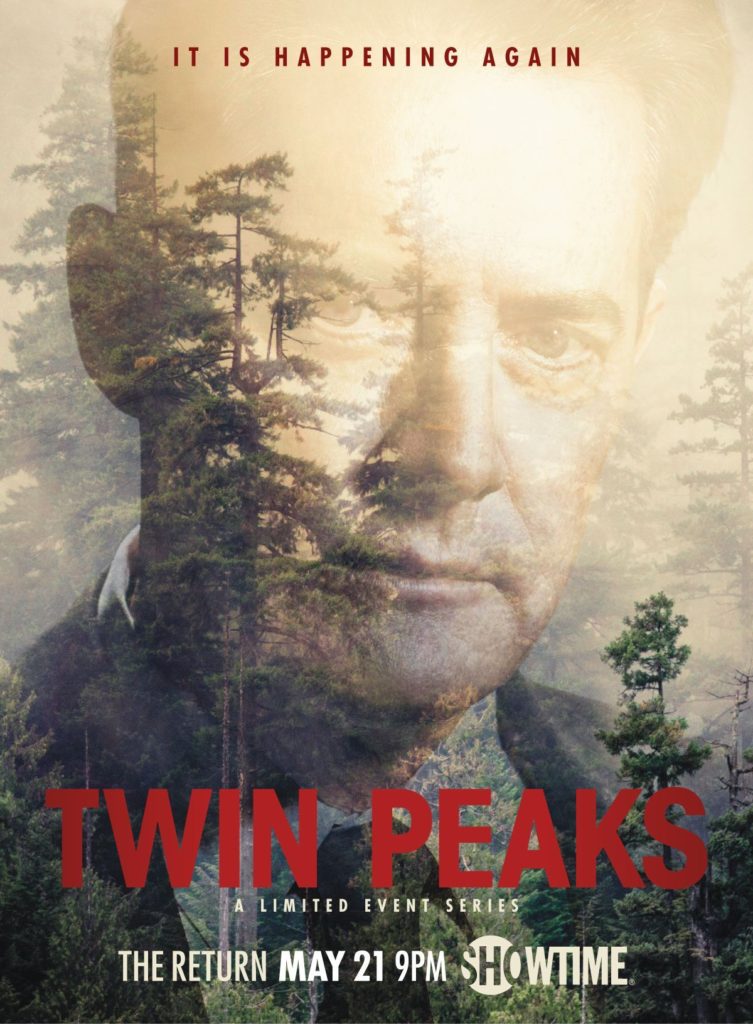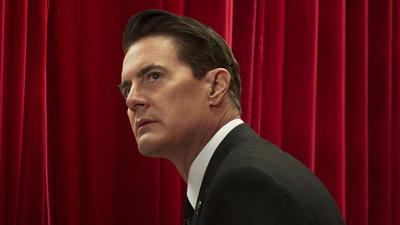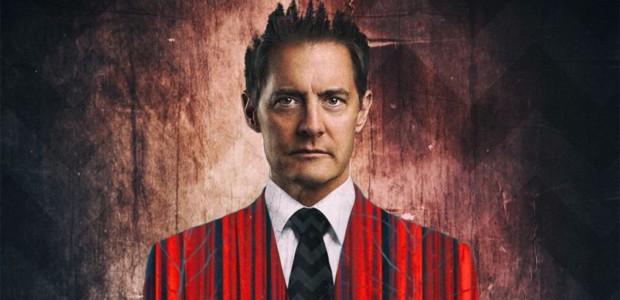
How, exactly, does one begin to process all this?
The only way one can, I suppose — one scene, one instance, one moment at a time.
After all, it’s been 25 years and, despite Laura Palmer’s promise, until it was first cryptically hinted at via twitter, then officially announced what already feels like countless months ago, I think it’s fairly safe to say that none of us thought this would happen. And yet, happening it is — “again,” as its promotional materials point out. David Lynch and Mark Frost’s Twin Peaks has, indeed, returned to television. And it’s been a “pinch yourself to make sure it’s real” night all the way.

Damn, but they did a good job of keeping all the details under wraps, didn’t they? In a world where the president of the United States feels compelled to spill classified info to the Russians in order to prove his dick still works (and that Mr. Putin’s money was well spent), it may be hard to believe that anyone can keep a secret anymore, but up until that red carpet (or should that be Red Room?) Hollywood screening the other night, nobody beyond the principals involved had any idea what was in store for us. No leaked scripts or rough-cuts or dailies. No wayward comments during interviews that hinted at just a little too much. Nothing. We went into this one as blind as we all did — scratch that, as those of us who were around did — when the original Twin Peaks first aired on ABC way back in 1990.
The fair question to ask, then, after all this time — is this even the same show?
Well, yes and no. In much the same way that the maligned-at-the-time-but-celebrated-now “prequel” film, TWIN PEAKS: FIRE WALK WITH ME marked a distinct tonal change from its small-screen progenitor, Twin Peaks circa 2017 both looks and feels entirely different to each of its forebears, and that’s as it should be: technology has moved on (this one’s shot in HD by the great Peter Deming), actors have aged, the budget’s bigger (Lynch having temporarily abandoned the project — God, remember that? — when it wasn’t), and being on Showtime means you can show tits, ass, blood, and viscera — all of which are reasonably well-represented in the two “part” (don’t call ’em episodes!) premiere “event” that just finished airing.
And yet those are all superficial changes. What strikes me as the greatest departure of all is the overall shift toward a slower, more measured, and decidedly more somber brand of storytelling than us old-time fans may be accustomed to. The pacing of these first two parts is more akin to Lynch’s still-criminally-under-appreciated LOST HIGHWAY than it is to “old-school” Twin Peaks, each rather lengthy scene dripping with both import and inherent tension in a way that simply can’t be faked. As we progress from Red Room/Black Lodge to the town of Twin Peaks “proper” to New York City to Buckhorn, South Dakota — and back, in turn, to each again, at least once – the daily minutiae of the various fictitious “lives” on display is given more-than-ample breathing space, and seemingly “unimportant” events, such as setting up an array of video cameras or waiting for someone to come to the door, play out very nearly in real time. This is, I admit, something that takes some getting used to — particularly as far as the scenes with the dude in New York who’s hired to observe a seemingly empty glass box go — but it ensures that when things do happen, they pack an enormous wallop. I’d tell you to ask that kid in the Big Apple I just mentioned, but alas, he’s in no shape to answer questions right now.

Death, in fact, is a constant specter hanging over the proceedings here — the inimitable Catherine E. Coulson, better known as “The Log Lady,” gives a heart-wrenching performance shot shortly before her demise that bravely incorporates aspects of her own illness; David Bowie’s Phillip Jeffries and Don S. Davis’ Major Garland Briggs both play significant roles by way of mere mention in the same scene; the late Miguel Ferrer will be along before too long — and, of course, there’s Laura Palmer. There’s always Laura Palmer. Is she alive? Is she dead? Is she both and neither at the same time? Actress Sheryl Lee is shown as having aged naturally, and when she finally plants a kiss on Agent Cooper’s lips it consummates what for many of us was the real, if entirely unspoken, love story at the heart of Twin Peaks as we knew it — but then she undergoes a transformation that further reinforces the idea that this isn’t, nor will it be, the Twin Peaks we thought we knew at all.
Except, of course, when it is. Paradoxically, the “unreal” world of the Red Room is where we find the most familiar faces — The Giant (Carel Struycken) kicks off the nostalgia parade followed in short order by Laura, Philip Gerard, the one-armed man (Al Strobel) — hell, even Leland Palmer (Ray Wise) turns up eventually. Change, evolution, and metamorphosis seems to be the through-line connecting all that goes on/has gone on beyond the scarlet-colored veil — exemplified most noticeably by “The Arm” (which sure ain’t an arm anymore) — so be forewarned : if you thought that time stood still for anybody trapped in this parallel (un?)reality, think again.

And that seems doubly true for Kyle MacLachlan’s Special Agent Dale Cooper, who’s apparently spent the better part of the past quarter-century sitting in the same chair. Or at least one of him has — his “BOB”-possessed doppleganger, last seen bleeding from the forehead and saying “How’s Annie?” over and over again front of a broken mirror, is busy raising all kinds of hell on our side of the dimensional divide, and his story provides the nearest thing to a straightforward and completely accessible plotline so far. That doesn’t mean we know where things are headed for him yet — not by any stretch — but his motivations are clearly spelled out in a way that little else here is, and MacLachlan just plain acts his ass off in this starkly uncharacteristic role. He even goes toe-to-toe with the great Jennifer Jason Leigh (his head and hands, mind you, being at entirely different level vis-a-vis her form) and dominates the screen to the point where you do a hey “hey, wait, isn’t that–?”-style double-take after she first makes her appearance. Put simply, he’s real good at being real bad.
My theory — and keep in mind, it’s only a theory — is that the emergence of “BOB” into our world via Doppleganger Dale is going to prove to have been the catalyst for a sort of “overall darkening” that’s taken place. Ya see, 2017 Twin Peaks, at least to date, seems to exhibit almost none of the charming quirkiness that endeared so many to the show last time around, the noble-but-brief efforts of Lucy Moran (Kimmy Robertson), Deputy Andy Brennan (Harry Goaz), and Horne brothers (blink and you’ll miss Ashley Judd as their new secretary) Ben (Richard Beymer) and Jerry (David Patrick Kelly) notwithstanding — and in its place we have a town where the mill stands in ruin, Dr. Jacoby (Russ Tamblyn) orders heavy equipment for a paranoia-fueled secret project deep in the woods, neither of the Sheriffs Truman (could a surprise appearance from Michael Ontkean at some point down the road be this series’ best-kept secret of all?) bother to show up for work, and Sarah Palmer (Grace Zabriskie) has graduated from “Invitation To Love” to graphic, “law of the jungle” nature documentaries. The ever-noble Deputy Hawk (Michael Horse) seems, as ever, to be the only one who just might have at least an intuitive understanding of what’s going on, but to this viewer, at least, it seems pretty clear that somewhere along the way, something went seriously wrong.
And yet, just when all seems irrevocably lost, we’re treated to a final scene at the “Bang Bang Bar” roadhouse, where Jacques Renault (Walter Olkewicz) still tends bar, Shelly Johnson (Madchen Amick) still drinks and gossips with her girlfriends, James Hurley (James Marshall) still stops in for a beer, and the nearest thing to a young version of Julee Cruise sings on stage. It’s all wrapped in a wistful, nostalgic glow that Lynch delivers with something akin to what I can only, and no doubt inadequately, describe as beauty tinged with sadness, and for those who were feeling out of their depth and/or comfort zones in the first hour-and-forty-five, it’ll most likely reel ’em back in — snap! — just like that.
As a study in contrasts, then — both with its previous version and, most interestingly, with itself — the first two parts of Twin Peaks 2017 border on the downright breathtaking. Whether we’re looking at a grisly (to put it mildly) quasi-ritualistic murder scene in South Dakota, watching the black-and-white flooring of the Red Room shift, rise, and fall, seeing “Bad Dale” drive a muscle car in the middle of the night, or even just staring into that (usually) empty glass box again, it’s impossible to turn away. Joe Bob Briggs once said that the cardinal rule for what makes a great drive-in movie is knowing that “anyone can die at any time” — Lynch and Frost one-up that here, though, by giving us a show where anything can happen at any time.
It’s happening again, indeed — and for the very first time.
Tags: Al Strobel, Ashley Judd, Carel Struycken, Catherine E. Coulson, David Bowie, David Lynch, David Patrick Kelly, Don S. Davis, Grace Zabriskie, Harry Goaz, James Marshall, Jennifer Jason Leigh, Julee Cruise, Kimmy Robertson, Kyle MacLachlan, Madchen Amick, Mark Frost, Michael Horse, Michael Ontkean, Miguel Ferrer, Peter Deming, Ray Wise, Richard Beymer, Russ Tamblyn, Sheryl Lee, South Dakota, TV, Walter Olkewicz


No Comments